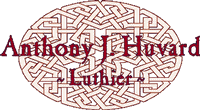
Exotic Hardwoods
The guitar need not be covered with candy apple finishes, flashy pearl inlay, or silver sparkle to be attractive. In fact, it's tough to beat Mother Nature when it comes to aesthetics. . . Thus I prefer to build guitars for the working pro, from a full range of selected imported and domestic hardwoods. I select material that is properly cut and seasoned and that exhibits unusually striking figure in its grain patterns for my custom instruments. In addition to the traditional choices for electric guitars, such as alder, maple, swamp ash, mahogany, I can also provide highly unusual one-of--a-kind pieces fabricated from a full range of exotic species as well. I Currently have these species available:
- alder (Alnus rubra)
- andaman paduak (Pterocarpus dalbergioides)
- black korina (Terminalia superba)
- Brazilian rosewood (Dalbergia nigra)
- birdseye mahogany (Swietenia macrophylla)
- birdseye maple (Acer saccharum), (Acer rubrum)
- carpathian elm burl (Ulmus campestris)
- cocobolo (Dalbergia retusa)
- East Indian rosewood (Dalbergia latifolia)
- Gaboon ebony (Diospyros piscatoria)
- figured Honduras mahogany (Swietenia macrophylla)
- flammed Acacia koa
- flammed maple (Acer macruphylum), (Acer saccharum) (Acer rubrum)
- flammed walnut (Juglans nigra)
- lacewood (Cardwellia sublimia)
- myrtlewood (Umbellularia californica)
- quilted maple (Acer macruphylum), (Acer rubrum)
- osage orange (Maclura pomifera)
- purpleheart (Peltogyne porphyrocardia)
- swamp ash (Fraxinus nigra)
- spalted maple (Acer saccharum)
- tulipwood (Dalbergia frutescens)
- walnut burl (Juglans nigra)
- white korina (Terminalia superba)
- wild black cherry (Prunus serotina)
- zebra wood (Dalbergia melawoxylon)
In addition to these species listed, I am constantly searching for unusual and unique billets of hardwood which I can prepare and season properly for use in solid body instruments. Oftentimes I have found such material in very small quantities, sufficient perhaps to produce only one or two instruments. Highly figured, properly seasoned hardwoods are becoming more and more difficult to find; that is why these highly figured woods are prized by guitar collectors and manufacturers with discriminating tastes. I use the figured overlays in combination with tone producing varieties in order to help modify the sound of chosen pickups or otherwise impart a distinct characteristic tone to the musical instruments produced from these materials. For instance, some manufacturers still use a relatively soft wood like alder to cut the harshness and the brittle edge from the sound of high output single coil pickups. Others gravitate toward heavier varieties of hardwoods such as swamp ash to produce greater sustain and a very bright sound from those same single coil pickups.
Some hardwood varieties tend to have better tone producing characteristics than others. . . . This is not to say that any one species is clearly superior to another; perception of tone of course is purely value judgement. . . but the consensus of most players needs to be taken into consideration when building an instrument designed for a specific use. By using figured overlays the best of both worlds can be achieved. A player can still enjoy the rich midrange tones enhanced by Honduras mahogany and provide the visual accents offered by heavily figured exotic hardwoods. The choice is left up to the player. A good builder can select from a range of materials to help provide the tone sought by each individual. Mother Nature provides an unparalleled pallet of colors and textures, and the imposition of intellect provided by the player and builder will create the perfect instrument for the application.
Our thanks to Woods of the World for technical information about hardwoods provided
at this Web site.
Photograph index | Reading List | FAQs | Home Page | E-mail
copyright 1997, anthony huvard, http://www.cybozone.com site maintained by cyboboy@cybozone.com

